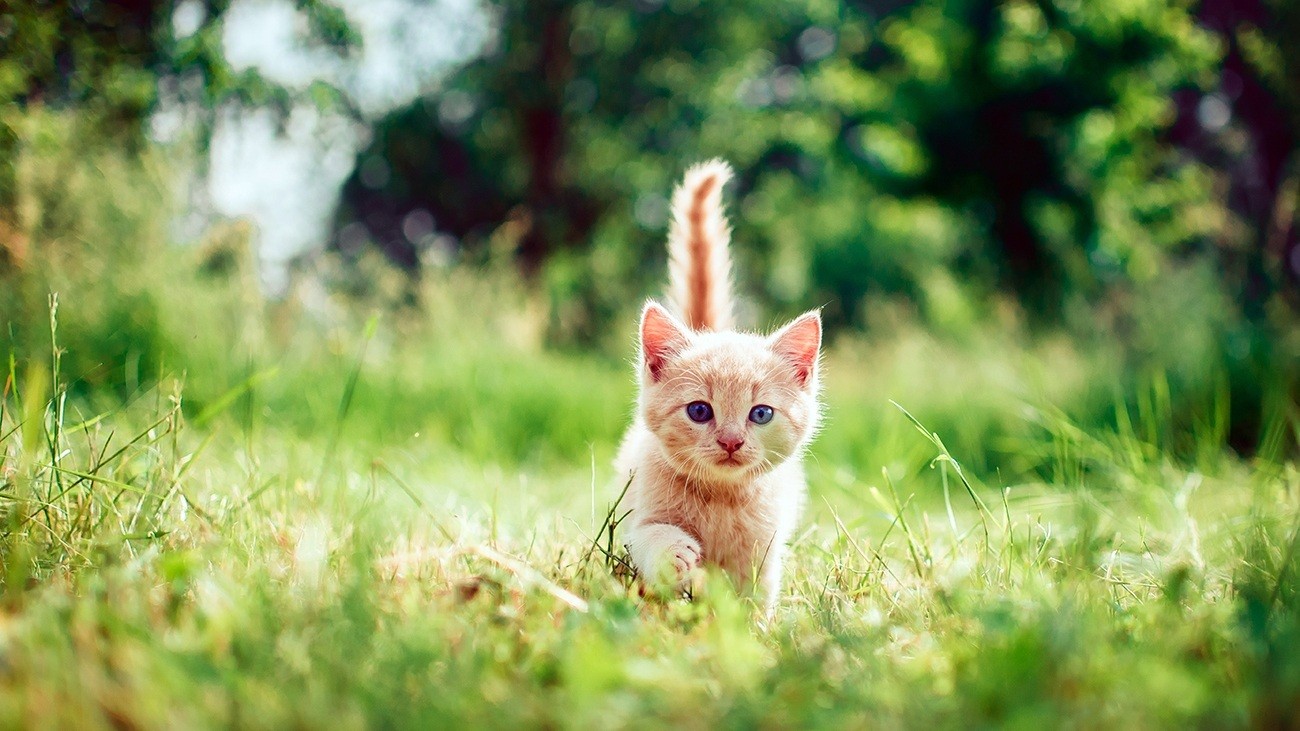Most owners are aware that using an appropriate kitten food formula during the early stages of a cat’s life is essential. But just how different are kitten foods from adult cat foods in terms of calories, protein, fat, and other nutritional values?
We took a closer look at 212 cat foods to see what the major differences were, and how the differences compare to our expectations of kitten food. To make the differences clearer, we made a few handy charts like the one below.
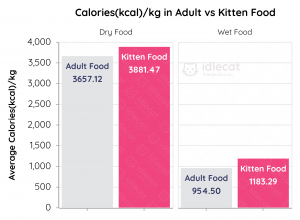
You can skip ahead to see:
… or read on to get a good idea of what differences we expect to see before we take a look at the data from the cat foods we examined.
- 1 What are the Differences We Expect to See, and Why?
- 2 The Differences between Kitten Food and Cat Food
- 3 Visualized Differences between Kitten Food and Adult Food
- 4 About the Data Used to Create this Article
What are the Differences We Expect to See, and Why?
For most breeds, cats under one year of age are considered Kittens. Larger breeds can have longer development stages; for example, Maine Coons can take up to two years to reach maturity.
During this stage, kittens develop rapidly and require a much higher energy intake, as much as three times more than that of adult cats.
Fat content. Fat provides a massive 9kcal of energy per gram, around twice the amount provided by protein and carbohydrates. High-energy diets (which kittens require) are sometimes used to promote weight gain, and are most commonly achieved by increasing the fat content.
We should expect kitten foods to be higher in fat content than adult foods.
Protein content. Proteins are the literal building blocks of organs and body tissues, so rapid growth calls for plenty of it. The food a kitten consumes should consist of at least 30% protein on a dry matter basis, though many (including myself) would advise aiming towards 40% or above.
Studies show that kittens are more sensitive to the quality of dietary protein than adult cats, so the minimum of 30% would require that all the protein was of a high biologic value (highly digestible and metabolizable), which is unlikely to be the case.
We should expect kitten foods to be similar or (ideally) higher in protein than adult foods.
Carbohydrate content. Carbohydrates remain hotly debated among cat owners. Plenty of owners to see them as a complete negative because carbohydrates aren’t an essential part of a cat’s diet.
The tendency of cheap cat foods to use carbohydrate fillers at the expense of protein and fat has done little to build trust between owners and manufacturers, but that’s an issue for another article!
Because of this bad feeling around carbs, I feel like carbohydrate content needs a little explanation before we set an expectation for it.
Excessive carbohydrate levels are, indeed, a bad thing; however, the simple carbohydrate glucose is metabolically essential. Specific body tissues (including the brain), require a constant supply of glucose. Cats can live without simple carbohydrates like glucose in their diet because of their ability to synthesize glucose (using glucogenic amino acids and glycerol) if it isn’t otherwise available.
Carbohydrates aren’t evil; they do provide energy. However, they should be limited to a low percentage of the matter that makes up your cat’s diet and shouldn’t be used as a replacement for essential macro-nutrients like fat and protein.
Dry foods are unfortunately packed with carbohydrates (carbs are required to create kibble), so for kittens it’s generally advisable to use wet food in combination with dry and avoid feeding dry foods alone.
Because of the relatively high protein and fat requirements of kittens, we should expect a lower level of carbohydrates when compared to adult food.
To summarize, relative to well-balanced adult cat foods, we should expect kitten foods to include:
- A similar or (ideally) higher protein content
- A much higher fat content
- A lower carbohydrate content
The Differences between Kitten Food and Cat Food
During this section we’ll look at the differences we saw when comparing 68 kitten foods with 144 adult foods. Both categories were split 50/50 in terms of wet and dry, and consist of foods that had all the required information available to compare nutrition on a dry matter basis.
Visualized Differences between Kitten Food and Adult Food
Numbers can be hard to take in quickly, the following charts show how kitten foods stack up against adult cat foods for a number of different criteria. All nutrient percentages used in the following charts are on a dry matter basis.
You can click on any chart to open it in a new tab and get a better view.
Calories per kg
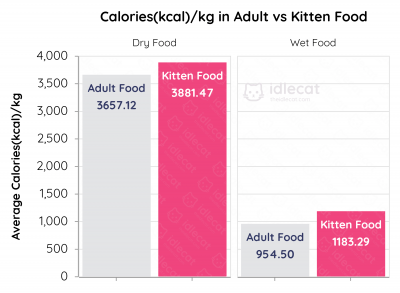
Kitten foods had more calories per kg than adult cat food formulas for both dry (3,881kcal vs. 3,657kcal) and wet (1,183kcal vs. 955kcal) forms.
That’s a 6.13% increase in dry food calories and a 23.87% increase in wet food calories, from adult food to kitten food.
Protein content
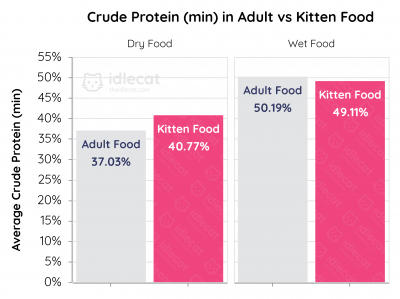
Dry kitten foods had more crude protein than adult foods (40.77% vs. 37.03%). Wet kitten foods had slightly less crude protein than adult foods (49.11% vs. 50.19%).
That’s a 10.1% increase in dry food crude protein, but a 2.15% decrease in wet food crude protein, from adult food to kitten food.
Fat content
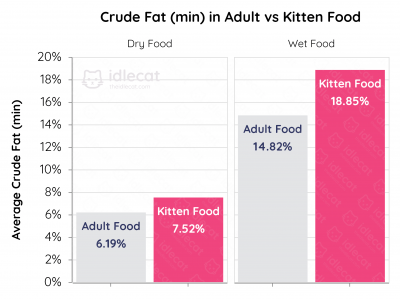
Kitten foods had significantly more crude fat than adult cat food formulas for both dry (7.52% vs. 6.19%) and wet (18.85% vs. 14.82%) forms.
That’s a 21.49% increase in dry food crude fat and a 27.19% increase in wet food crude fat, from adult food to kitten food.
Fiber content

Kitten foods had less crude fiber than adult cat food formulas for both dry (4.22% vs. 5.33%) and wet (6.41% vs. 6.65%) forms.
That’s a 20.83% decrease in dry food crude fat and a 3.61% decrease in wet food crude fiber, from adult food to kitten food.
Carbohydrate content
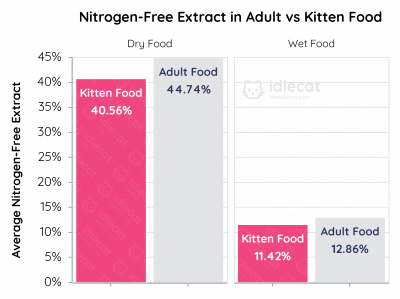
The nitrogen-free extract is an estimate of nonfibrous carbohydrates, such as sugars and starches.
Kitten foods had fewer carbohydrates (NFE) than adult cat food formulas for both dry (40.56% vs. 44.74%) and wet (11.42% vs. 12.86%) forms.
That’s a 9.34% decrease in dry food carbs and an 11.2% decrease in wet food carbs, from adult food to kitten food.
Taurine content
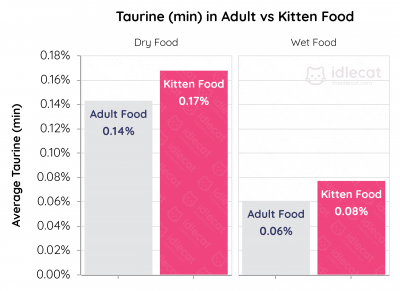
Kitten foods had more taurine than adult cat food formulas for both dry (0.17% vs. 0.14%) and wet (0.08% vs. 0.06%) forms.
That’s a 21.43% increase in dry food taurine and a 33.33% increase in wet food taurine, from adult food to kitten food.
Price per lb
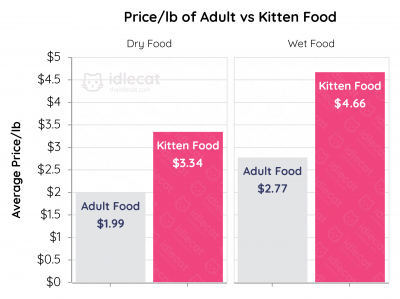
Kitten foods were considerably more expensive per lb than adult cat food formulas for both dry ($3.34 vs. $1.99) and wet ($4.66 vs. $2.77) forms.
That’s a 67.84% increase in dry food price per lb and a 68.23% increase in wet food price per lb, from adult food to kitten food.
Summary of the Differences between Kitten Food and Adult Cat Food
Summary: We found that kitten foods were notably higher in calories, fat content, and taurine than adult cat foods, but lower in fiber and carbohydrate content. Protein content was similar between the two. Kitten foods were considerably (~+68%) more expensive than adult foods.
These differences match up pretty well with the expectations we established in the previous section.
If there’s one thing that surprised us a little it’s the excellent 50% dry matter basis protein content of both adult and kitten wet foods; perhaps we just happened to pick fantastic examples of good adult cat food when collecting our data.
The tables below summarize the differences between Kitten and Adult food for each aspect that we examined.
Please note: green and red highlighting only shows the direction of the change, it does not indicate whether the change is better or worse.
Dry Adult vs Kitten Food Comparison Table
| Dry Food | Adult | Kitten | % Change |
|---|---|---|---|
| kcal/kg | 3,657 kcal | 3,881 kcal | +6.13% |
| Protein (min) | 37.03% | 40.77% | +10.1% |
| Fat (min) | 6.19% | 7.52% | +21.49% |
| Fiber (max) | 5.33% | 4.22% | -20.83% |
| Carbs (NFE) | 44.74% | 40.56% | -9.34% |
| Taurine (min) | 0.14% | 0.17% | +21.43% |
| Price/lb | $1.99 | $3.34 | +67.84% |
Wet Adult vs Kitten Food Comparison Table
| Wet Food | Adult | Kitten | % Change |
|---|---|---|---|
| kcal/kg | 955 kcal | 1,183 kcal | +23.87% |
| Protein (min) | 50.19% | 49.11% | -2.15% |
| Fat (min) | 14.82% | 18.85% | +27.19% |
| Fiber (max) | 6.65% | 6.41% | -3.61% |
| Carbs (NFE) | 12.86% | 11.42% | -11.2% |
| Taurine (min) | 0.06% | 0.08% | +33.33% |
| Price/lb | $2.77 | $4.66 | +68.23% |
About the Data Used to Create this Article
Here’s a sneak peek at the spreadsheet we compiled to fuel the charts and findings:
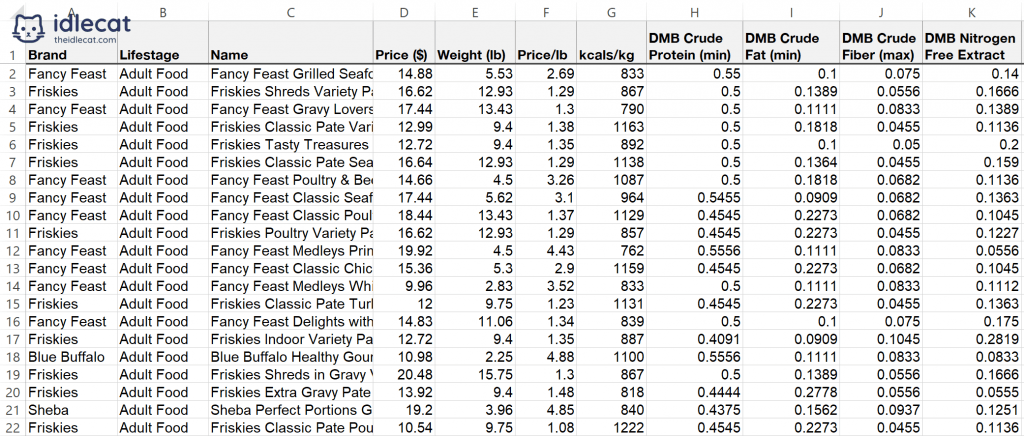
There are a few things worth noting about this particular data set:
There are more adult foods than kitten foods. Consistent data on kitten food is hard to find. There’s a lot more choice available to us for regular cat food, and several kitten foods get labeled as suitable for kittens and adults. We excluded foods labeled suitable for both life stages, to get a better picture of the difference between foods explicitly formulated for each. The result of this is that our averages will be slightly better formed for adult foods than kitten foods, but in the grand scheme of things, they’re both still pretty small sample sizes.
There are equal counts of wet and dry food forms for each formula. Both the data for kitten and adult food consisted of a 50/50 split of wet and dry foods. For example, of the 144 dry foods, 72 were wet, and 72 were dry foods.
The data is only as accurate as each guaranteed analysis. Guaranteed analysis values work on “max” and “min” values. The AAFCO requires that cat foods list Crude Protein (min), Crude Fat (min), Crude Fiber (max), and Moisture (max). These values are used to calculate each nutrient on a dry matter basis.
Ash content is estimated where unavailable. Ash is required when calculating the Nitrogen-Free extract (carbohydrate) content. Ash isn’t one of the values that cat food manufacturers are required to disclose. Some do, some don’t. For foods where no ash (max) value was available, an estimate of 3.0% for wet foods and 6.0% for dry foods was used, as per this article by Dr. Jennifer Coates, DVM.
Prices noted from Chewy.com are only correct at the time of publishing. I’m a huge fan of Chewy, and find that they consistently offer the lowest prices on cat food online. I looked up price data for each product where available and took the current list price.
Did you find this article helpful?
